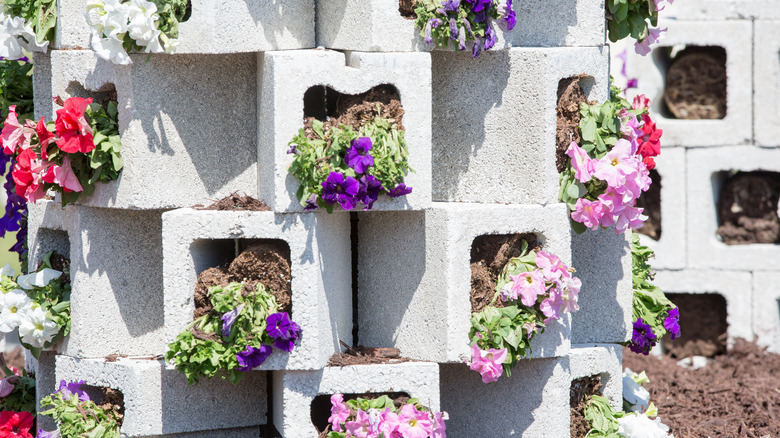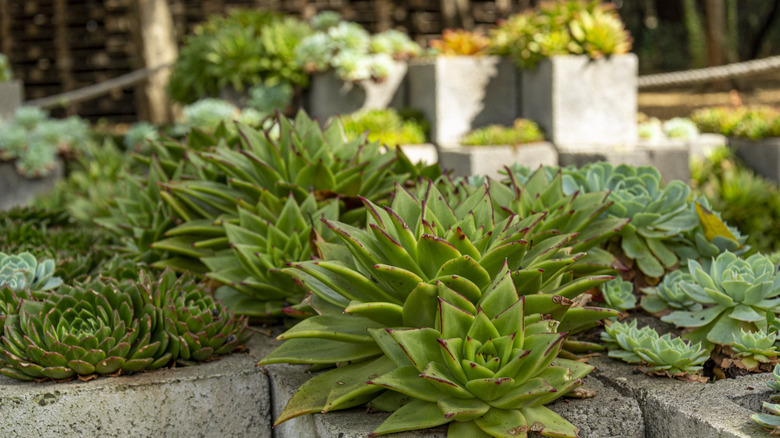Transform Plain Cinder Block Into A Colorful Vertical Garden
Small-footprint and tight-budget gardening are more similar than you'd think: you need to be resourceful when it comes to materials, plants, and space. Vertical gardens solve the space issue, let you express your creativity, and, if you build one from cinder blocks, won't break the bank. The blocks can be bought from your local hardware store for a few dollars. Once home, stack them however you like, joining them with landscape adhesive. Then, all that's left is to paint (if you wish), fill, and plant.
You might be coming into this project already knowing where your vertical cinder block garden will go, or you may just love the modular concept. Either way, choosing where to put your planter is a crucial design step. Ideally, the spot will have a sturdy floor (think dirt, stone, or concrete). Avoid wood: cinder blocks are heavy and could eventually fall through, say, a wooden deck. They also tend to accumulate moisture, making rot a real issue. The soil in cinder blocks tends to dry out fast, so choose a location with dappled shade or sun for only part of the day.
Colorwise, consider the background behind your planter. If it's neutral, you can really go wild with color, whether that's paint or flower hues. If it's already heavily patterned or brightly colored, you may have to tone down the shades you use.
Choosing the right blocks
Cinder blocks are sometimes called concrete blocks or CMUs. They're all essentially the same: construction blocks made by mixing water, cement, and aggregate. They come in an enormous variety of shapes, sizes, and materials. It can be fun to mix and match blocks when creating your vertical garden. Always choose blocks with large hollows, like this regular construction block going for $2.05 at Menards or this square-cored concrete block for $1.98 from Lowes. The more room for soil, the better!
A word of caution: cinder blocks are designed for construction, not gardening. They may be exposed to harmful substances like fly ash and factory site contamination, found either in the material itself or at the place they're manufactured. This is fine if you're creating a sculptural cactus and succulent garden, but not great for food plants.
What about color? If you've decided to paint your blocks, you'll need to buy something suitable for outdoor use, like matte, semi-gloss, or gloss latex paint. You can add the color of your choice to Walmart's ColorPlace Classic Exterior Paint. This 1-gallon American's Finest flat latex paint, available at Home Depot, is designed for use on masonry walls. Don't underestimate how much paint you'll need, either. The rough surface of cinder blocks is porous, and you may need to apply multiple coats to get a vibrant finish. If you want to get really creative, play around with techniques like stenciling (for bold, precise patterns) or a distressed paint look.
Channel your inner Lego kid
Before assembling your vertical garden, you need to make sure it looks good in the location you want it. Even if you're not a great artist, put pen to paper and create a rough sketch of your design or use digital 3D modeling software. You can also arrange the blocks on the site, take a reference photo, and disassemble them again. Instead of piling the blocks one atop another brick wall-style, vary the direction of the bricks horizontally and even diagonally so some stick outwards from the central structure. This haphazard arrangement looks great when the blocks are painted in different colors, too!
Grab a tube of construction adhesive, a caulk gun, and some lining material — sheet metal, landscaping fabric, plastic sheet, or even some old clothes. Cover the ground with the lining material, following the future footprint of your planter. Assemble the first layer of bricks, applying the adhesive between them to stick them together. Stack the next layer, again using glue on any sides that join. Continue until your planter is finished. Now, all that's left to do is paint the cinder blocks and fill your creation with colorful plants that will work in a verticle garden.

